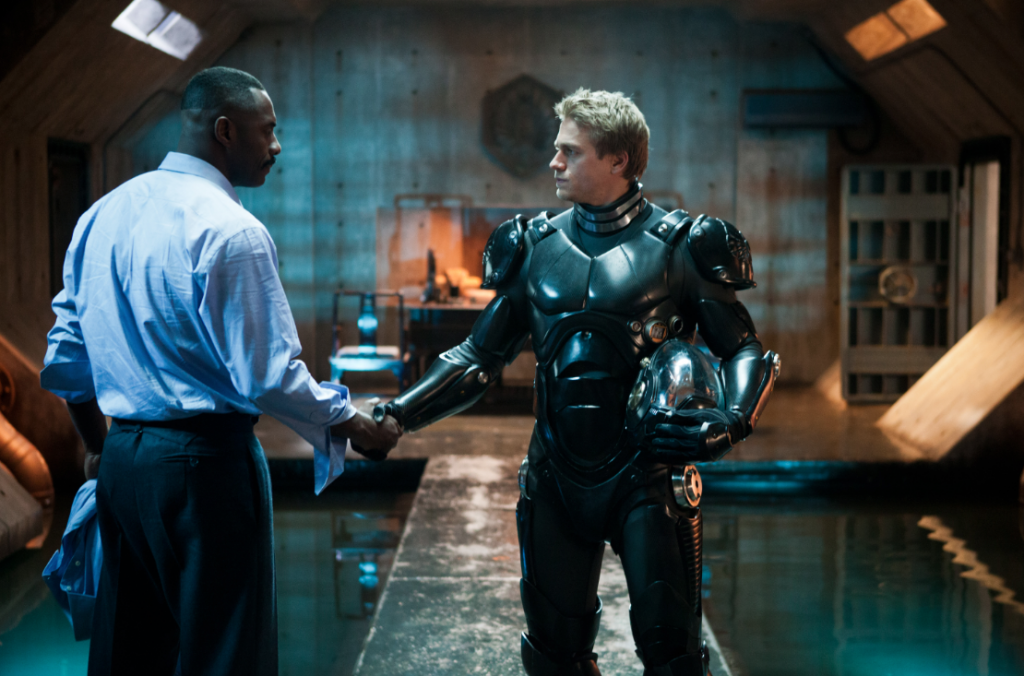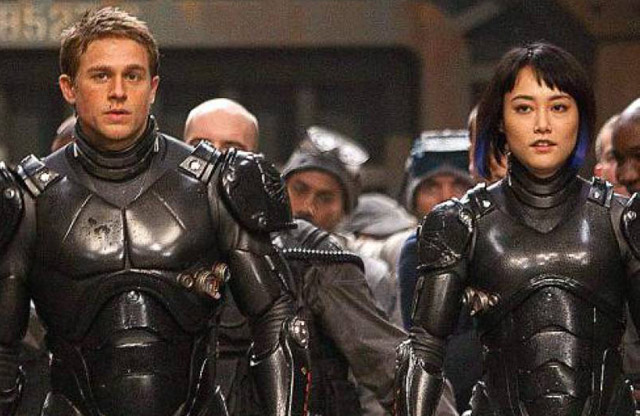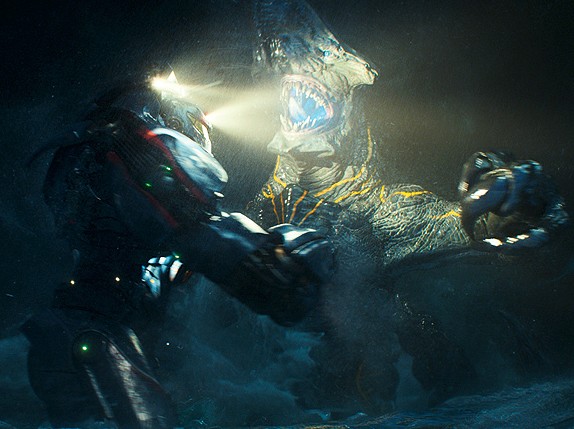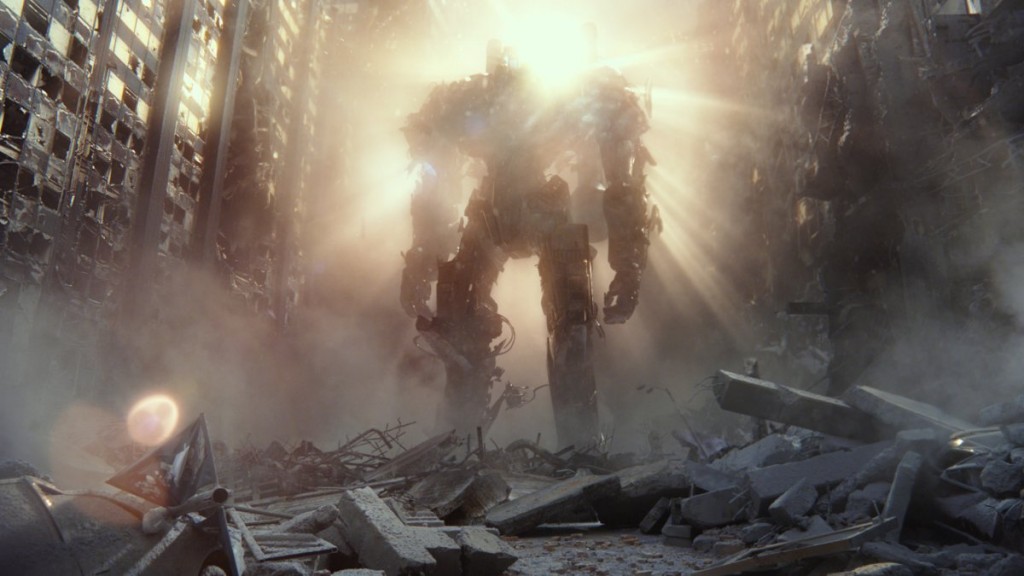Pacific Rim (2013)
CAST: Charlie Hunnam, Idris Elba, Rinko Kikuchi, Charlie Day, Ron Perlman, Burn Gorman, Max Martini, Robert Kazinsky, Clifton Collins Jr.
REVIEW:
Guillermo del Toro’s (Mimic, Pan’s Labyrinth, Hellboy) love letter to the kaiju (Japanese monster movie) and anime genres, Pacific Rim serves up enough spectacular visual effects and kinetic action sequences to at least momentarily distract from its weaknesses in narrative and character development. It doesn’t leave the deepest lasting impression once it’s over, but when the effects extravaganza kicks in, it’s certainly not hard to get swept up in the thrill of the moment.
The set-up is explained in an opening prologue. Years before the start of the film, massive destructive creatures called kaiju (the Japanese word for “monster”) emerged from the ocean depths and began assaulting major cities around the globe without warning or explanation. After conventional weapons proved inadequate, the Jaeger (pronounced “Yaeger” and the German word for “hunter”) program was born, constructing enormous robots, operated by two mind-linked human pilots, that could take the kaiju on hand-to-hand. For a time, the jaegers seem to gain the upper hand, mankind breathes a little easier, and the pilots achieve rock star popularity. Then things start going downhill. The kaiju get bigger and their attacks more frequent, and the jaegers are ground down until only four remain. The program’s funding is cut, and Marshal Stacker Pentecost (Idris Elba) carries it on as an underground resistance movement. Pentecost tracks down former star pilot Raleigh Beckett (Charlie Hunnam), who fell off the radar after the death of his brother in battle and the destruction of his jaeger, and pulls him back into the fight. Raleigh is paired up with Mako Mori (Rinko Kikuchi), a Japanese girl raised by Pentecost after being orphaned by a kaiju attack in her childhood. The team-up gets off to a rocky start, when Mako’s inexperience nearly causes a dangerous accident in the hangar bay, but when a tag team of kaiju attack Hong Kong and disable the other jaegers, Pentecost has no choice but to send them into the fray.
Admittedly, Pacific Rim is not as original or groundbreaking as its most ardent defenders would have you believe. Actually, it’s a bit like Godzilla, Transformers, and the popular anime series Gundam tossed into a blender. How much the idea of that intrigues you might be a decent barometer of how much you’re likely to enjoy yourself. The movie carries a kick on a visceral level; it’s big, loud, and fun, and the action sequences pack a kinetic punch. The visual effects are first-rate, and the first appearances of both the jaegers and the kaiju are imposing. When it kicks into full gear with the lengthy Hong Kong battle two-thirds of the way through, Pacific Rim serves up mass destruction with the best of them, standing in worthy company alongside the likes of Transformers and Independence Day.
 Also like its aforementioned cinematic cousins, Pacific Rim unabashedly deals in stock character types. The characters are all archetypes: the bad boy with mad skills who dropped out of the game and gets pulled back in for a shot at redemption, the tough girl secretly in love with the bad boy, the gruff but noble mentor figure who gives clichéd pep talks about second chances and a “rousing” climactic speech before the final battle, the “comic relief” nerdy scientists, the asshole rival pilot who gets a heroic sacrificial redemption, etc. The characters are all thinly-developed. The only ones with enough scrap of backstory to set them above the heap are Raleigh, Mako, and Pentecost, and of those, only Mako approaches three-dimensionality. She gets the most poignant human sequence in the movie, a flashback of the kaiju attack that left her a terrified orphan in the streets. In a curious paradox, while the characters are thinly-developed, the plot feels unnecessarily convoluted, with laborious exposition expended on kaiju brains and the inter-dimensional rift they emerge from. A lot of the dialogue is clunky and cheesy, in line with Independence Day (right down to an overblown “rousing” pre-battle speech) or Transformers. I’d set Pacific Rim a notch above both of those, though, better-paced than Independence Day and with marginally more human characters than the non-entities in Transformers. As if trying to keep the mass destruction from making things too dark, del Toro overcompensates with “comic relief” courtesy of an annoying pair of bickering scientists (Charlie Day and Burn Gorman) who eat up too much screentime, along with an extraneous subplot involving a black market dealer of kaiju remains (Ron Perlman). Still, Pacific Rim never gets nearly as bogged down in meandering subplots as Independence Day did to a sometimes interminable extent, and while the characters aren’t exactly deep, del Toro makes more effort with character development and relationships than anything to be found in Transformers.
Also like its aforementioned cinematic cousins, Pacific Rim unabashedly deals in stock character types. The characters are all archetypes: the bad boy with mad skills who dropped out of the game and gets pulled back in for a shot at redemption, the tough girl secretly in love with the bad boy, the gruff but noble mentor figure who gives clichéd pep talks about second chances and a “rousing” climactic speech before the final battle, the “comic relief” nerdy scientists, the asshole rival pilot who gets a heroic sacrificial redemption, etc. The characters are all thinly-developed. The only ones with enough scrap of backstory to set them above the heap are Raleigh, Mako, and Pentecost, and of those, only Mako approaches three-dimensionality. She gets the most poignant human sequence in the movie, a flashback of the kaiju attack that left her a terrified orphan in the streets. In a curious paradox, while the characters are thinly-developed, the plot feels unnecessarily convoluted, with laborious exposition expended on kaiju brains and the inter-dimensional rift they emerge from. A lot of the dialogue is clunky and cheesy, in line with Independence Day (right down to an overblown “rousing” pre-battle speech) or Transformers. I’d set Pacific Rim a notch above both of those, though, better-paced than Independence Day and with marginally more human characters than the non-entities in Transformers. As if trying to keep the mass destruction from making things too dark, del Toro overcompensates with “comic relief” courtesy of an annoying pair of bickering scientists (Charlie Day and Burn Gorman) who eat up too much screentime, along with an extraneous subplot involving a black market dealer of kaiju remains (Ron Perlman). Still, Pacific Rim never gets nearly as bogged down in meandering subplots as Independence Day did to a sometimes interminable extent, and while the characters aren’t exactly deep, del Toro makes more effort with character development and relationships than anything to be found in Transformers.
Also, the movie actually avoids at least one cliché by not shoehorning an overt romance in between Raleigh and Mako. While the two have clear sexual tension and romantic undertones, and may well be on their way to becoming more than just platonic comrades-in-arms, the movie doesn’t force it on us before it feels properly established (Man of Steel, I’m looking at you). While Pacific Rim helps itself to various other clichés, it’s kind of refreshing to see a movie where the boy and girl don’t immediately tumble into bed or close things out with an ending makeout session.
 Somewhat unusually for a big summer action/effects extravaganza, Pacific Rim doesn’t really have any “names” in its cast. Charlie Hunnam is probably best-known for the biker gang television series Sons of Anarchy (though he also has a few movies under his belt), and Idris Elba is probably best-known as the lead on the British detective series Luther (he was also the gate guardian Heimdall in Thor and the ship captain in Prometheus). Hunnam seems hamstrung by wrestling with an American accent that often makes his line delivery sound stiff and monotone (he was far less wooden in 2005’s Green Street Hooligans, where he spoke with his natural English accent). Hunnam is more effective when he’s not talking; he looks the part of the hunky hero, he’s buff and moves well, and one of the biggest and most memorable “character scenes” is a hand-to-hand duel between he and Mako fueled by sexual tension. Japanese actress Rinko Kikuchi compensates for her limited command of English with an expressive face. She provides the movie’s most human moments, and she and Hunnam mesh effectively enough to be an appealing pair, and for us to buy them as a close partnership with romantic undertones. Idris Elba brings his authority to bear as Pentecost; his “rousing” speech is just as cornily overwrought as Bill Pullman’s in Independence Day, but Elba has a more commanding presence. Charlie Day plays his goofball scientist like he’s combining impressions of Rick Moranis and Sam Rockwell. Burn Gorman is in even more broad mode, spitting his lines in a nearly unintelligible accent and hobbling manically around with a cane like he’s made a careful study of a series of mad scientists in ’50s B movies. They go overboard with their shtick, and are frequently more side distractions than effective comic relief. Frequent del Toro collaborator Ron Perlman is probably the most familiar face in the supporting cast, but his character is superfluous. There is also a father-son team of Australian pilots (Max Martini and True Blood‘s newest heartthrob Robert Kazinsky), whose Aussie accents are overdone to the point of caricature and whose subplot doesn’t generate the impact it was aiming for because they’re so thinly-developed.
Somewhat unusually for a big summer action/effects extravaganza, Pacific Rim doesn’t really have any “names” in its cast. Charlie Hunnam is probably best-known for the biker gang television series Sons of Anarchy (though he also has a few movies under his belt), and Idris Elba is probably best-known as the lead on the British detective series Luther (he was also the gate guardian Heimdall in Thor and the ship captain in Prometheus). Hunnam seems hamstrung by wrestling with an American accent that often makes his line delivery sound stiff and monotone (he was far less wooden in 2005’s Green Street Hooligans, where he spoke with his natural English accent). Hunnam is more effective when he’s not talking; he looks the part of the hunky hero, he’s buff and moves well, and one of the biggest and most memorable “character scenes” is a hand-to-hand duel between he and Mako fueled by sexual tension. Japanese actress Rinko Kikuchi compensates for her limited command of English with an expressive face. She provides the movie’s most human moments, and she and Hunnam mesh effectively enough to be an appealing pair, and for us to buy them as a close partnership with romantic undertones. Idris Elba brings his authority to bear as Pentecost; his “rousing” speech is just as cornily overwrought as Bill Pullman’s in Independence Day, but Elba has a more commanding presence. Charlie Day plays his goofball scientist like he’s combining impressions of Rick Moranis and Sam Rockwell. Burn Gorman is in even more broad mode, spitting his lines in a nearly unintelligible accent and hobbling manically around with a cane like he’s made a careful study of a series of mad scientists in ’50s B movies. They go overboard with their shtick, and are frequently more side distractions than effective comic relief. Frequent del Toro collaborator Ron Perlman is probably the most familiar face in the supporting cast, but his character is superfluous. There is also a father-son team of Australian pilots (Max Martini and True Blood‘s newest heartthrob Robert Kazinsky), whose Aussie accents are overdone to the point of caricature and whose subplot doesn’t generate the impact it was aiming for because they’re so thinly-developed.
 The first two-thirds or so of Pacific Rim are the strongest. The set-up is effective, and del Toro puts some legitimate effort into developing the central pair and their relationship, giving Pacific Rim a little (key word: little) more human interest than just an empty special effects extravaganza. The centerpiece action sequence, the battle against two kaiju in Hong Kong, is visually impressive, though the fact that del Toro chooses to film every fight scene at night in heavy rain both threatens to make every fight start to look the same, and sometimes makes it hard to make out exactly what’s happening blow-by-blow. That said, fans of balls-to-the-wall action rumbles will appreciate how del Toro gleefully throws the kitchen sink at them, especially the sheer awesome factor of a jaeger hitting a kaiju in the face with a cruise ship. It’s the kind of thing you won’t see anywhere else that almost makes the price of admission worth it by itself. In fact, after this all-out action brew-ha, the movie’s climax by comparison feels anti-climactic. Pacific Rim blows its wad a little too early, and fails to top itself in the final battle. The ending is a little abrupt.
The first two-thirds or so of Pacific Rim are the strongest. The set-up is effective, and del Toro puts some legitimate effort into developing the central pair and their relationship, giving Pacific Rim a little (key word: little) more human interest than just an empty special effects extravaganza. The centerpiece action sequence, the battle against two kaiju in Hong Kong, is visually impressive, though the fact that del Toro chooses to film every fight scene at night in heavy rain both threatens to make every fight start to look the same, and sometimes makes it hard to make out exactly what’s happening blow-by-blow. That said, fans of balls-to-the-wall action rumbles will appreciate how del Toro gleefully throws the kitchen sink at them, especially the sheer awesome factor of a jaeger hitting a kaiju in the face with a cruise ship. It’s the kind of thing you won’t see anywhere else that almost makes the price of admission worth it by itself. In fact, after this all-out action brew-ha, the movie’s climax by comparison feels anti-climactic. Pacific Rim blows its wad a little too early, and fails to top itself in the final battle. The ending is a little abrupt.
Pacific Rim may sport more style than substance, but it’s bolstered by spectacular visual effects and a big, loud, whizz-bang sense of fun. Del Toro’s fanboy levels of love for the kaiju and anime genres shines through, and he proves he knows how to handle large-scale visual effects when given command of an unlimited budget. One never senses the movie is trying to be any more profound or deep than it is, and in fact gleefully embraces its own borderline ridiculousness. Pacific Rim definitely won’t be everyone’s cup of tea, and it’s not for those seeking a deep cinematic experience, but it’s an easily diverting action/effects extravaganza good for a couple hours of straightforward “big summer movie” entertainment.
* * 1/2
